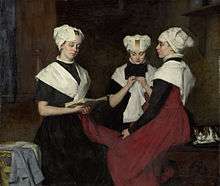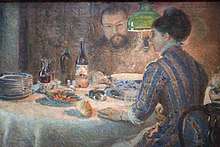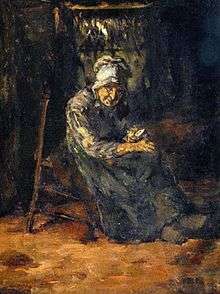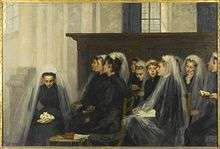Amsterdamse Joffers
The Amsterdamse Joffers were a group of women artists in Amsterdam who met weekly in the last quarter of the 19th century to paint and show their works together. They were known for their style that followed the example of the Amsterdam Impressionists, and were all members of the Amsterdam artist societies Arti et Amicitiae and Sint Lucas, and most followed the lessons by professor August Allebé of the Rijksakademie van beeldende kunsten of Amsterdam.

History

In the late 19th century and early 20th century in Amsterdam a group of young women had come together to found a circle. Their goal was to pursue painting as a form of art. They came from wealthy families, and were therefore not forced to fight their livelihoods. They had almost all the visited the Rijksakademie van beeldende kunsten of Amsterdam. One exception was Sue Robertson, who had visited the Polytechnic in Delft and received private drawing lessons. Lizzy Ansingh had received private lessons in addition to the lessons with August Allebé, Nicolaas van der Waay and Carel Dake. Nelly Bodenheim was an illustrator and was thus not a painter in the sense of this art movement more. Coba Ritsema initially received her education in the Haarlem he School of Art and than at the Rijksakademie van beeldende kunsten Amsterdam - there she was in a women's group. - Here she was taught from August Allebé, Nicolaas van der Waay and Carel Dake, too. She received from Thérèse Schwartze, Jacob Ritsema (her brother), Carel Lodewijk Dake, George Hendrik Breitner and Fredik Theodorus Grabjin secondary education. Some of her students were Coba Suri, Jan van den Hengst, Tine Honey, Victoire Winix and Lize Duyvis.
This group was made up to a circle. They had weekly a meeting in the house of Thérèse Schwartze. Subject was the exchange of experiences from her work as an artist.[1]
Sue Robertson, Jacoba Surie, Johanna Elisabeth Westendorp-Osieck and Coba Ritsema were members of Arti et Amicitiae and Pulchri Studio.
In 1912, this movement received the name Amsterdamse Joffers by art critic Albert Plasschaert . This word was used in a newspaper article.
Style and work
Art historically, the Amsterdamse Joffers are assigned to the Impressionists and the era of Dutch Late Impressionism.[2] In her paintings dominated still life and portraiture. On a little scale they had also adopted the genre.
Prizes and exhibitions
In 1910 Coba Ritsema won the bronze medal at the international exhibition in Brussels. Between 1912 and 1923 she won the silver medal of the city of Amsterdam, and in 1918 the Royal Medal was presented to her by the Queen Wilhelmina.
In 1906 Lizzy Ansingh and in 1910 Elsa van Doesburg hat won the Willink van Collenprijs of the art association Arti et Amicitiae Amsterdam.[3][4][5]
International comparison


If one looks to France, the country of origin of impressionism, there are four women painters.[6] These are Marie Bracquemond (1840-1916), Mary Cassatt (1845-1926), Eva Gonzalès (1847-1893) and Berthe Morisot (1841-1895). Art Historically, they count on the core of the French movement. Characteristic of her paintings is the powerful, light-filled color palette with lively motifs. This is rounded off with the typical for the impressionism lighting.
When comparing these four women painters with the female flow of Dutch Impressionism, there are a number of points. The Dutch women lived later, so they may have taken the work of the French women only as a model. The Dutch color palette is more representative of the severity of the darker colours of the 1st generation and some of the more vivid palette of the 2nd generation of the Hague School.[7] Here is the quiet and melancholy, which emanates from the chosen darker colours. The French women had chosen the genre, the landscape painting (coastal, harbor and countryside with views of the city), still life and the portrait. The Dutch women on the other hand choose almost exclusively the still life and the portrait. The still life of frenchwomen is marked by an ease. The Dutch women do not equal, there is a dark, oppressive melancholy in the painting.
These paintings by international standards - here with France - are also the best example of the unique mentality of the countries and the influence in their painting. This is an essential feature of the art movement of impressionism, too.
Members of the circle

- Lizzy Ansingh (1875–1959)
- Jo Bauer-Stumpff (1873–1951)
- nl:Ans van den Berg (1873–1942)
- Nelly Bodenheim (1874–1951)
- nl:Marie van Regteren Altena (1868–1958)
- Jacoba Johanna (Coba) Ritsema (1876–1961)
- Suze Bisschop-Robertson (1855–1922)
- Thérèse Schwartze (1851–1918)
- Jacoba Surie (1879–1970)
- Johanna Elisabeth (Betsy) Westendorp-Osieck (1880–1968)
They are not closely acquainted
- Elsa van Doesenburg (1875–1957)
- Josepha Johanna Julia Marie Tepe (1884–1962)
- Marie Waldscheer (1855–1936)
Some selected works

- Lizzy Ansingh: The sourcer of life, 124,5 × 174 cm, oil
- Ans van den Berg: White and red azaleas, 76 × 65 cm, oil
- Jacobe Surie: Pisces, 50 × 70,2 cm, oil on canvas
- Betsy Westendorp: Still life with glass paint pots, 25,0 × 19,4 cm, oil on canvas
- Jo Bauer-Stumpf: Still life with anemones, 56,9 × 48 cm, oil on canvas
- Coba Ritsema: Girl in a studio, 32,4 × 46,5 cm, oil on canvas
- Johanna Elisabeth Westendorp-Osieck: Still life with cancer, 23,6 × 24,5 cm, oil on canvas
- Marie van Regteren Altena: Atelier with nacked modell, 51,2 × 76,8 cm, oil on canvas
- Ans van den Berg: Still life with chrysanthemum, 40,8 × 76,8 cm, oil
- Nelly Bodenheim: Illustrations of hand posters
- Suze Bisschop-Robertson: Sleeping girl in the sun, oil
- Thérèse Schwartze: Portrait of Lizzy Ansingh, 40,4 × 49,4 cm, oil
Museum Guide of the Amsterdamse Joffers

- Breda Museum, Breda
- Dordrechts Museum, Dordrecht
- Gemeentmuseum, Den Haag
- Musée du Jeu de Paume, Paris
- Museum Boijmans, Rotterdam
- Rijksmuseum, Amsterdam
- Stedelijk Museum, Amsterdam
- Van Abbemuseum, Eindhoven
- Centraal Museum, Utrecht
Exhibitions
- 1903 Stedelijke internationale tentoonstelling van kunstwerken van levende meesters, Stedelijk Museum, Amsterdam.
- 1905 Thérèse Schwartze represented in the exhibition of works of art from Wiesbaden and Biebrich private Collections[8]
- 1905 Lizzy Ansingh, Jacoba Ritsema and Marie van Regteren Altena in the collection of the "Arti et Amicitiae" and "Pulchri Studio" - Kunstverein in Hamburg zu Hamburg[9]
- 1907 Stedelijke internationale tentoonstelling van kunstwerken van levende meesters, Stedelijk Museum, Amsterdam.
- 1912 Stedelijke internationale tentoonstelling van kunstwerken van levende meesters, Stedelijk Museum, Amsterdam.
- 1913 Exhibition: Women from 1813 to 1913 - Stedelijk Museum Amsterdam
- 1955 Suze Robertson - Rijksmuseum Amsterdam
- 1984 Suze Robertson - Stedelijk Museum Amsterdam
- 1991 Lizzy Ansingh in a joint exhibition in Amsterdam
- 1991 Nelly Bodenheim - Amsterdam Historical Museum
- 2003/2004 Suze Robertson - Museum Rijswijk
- 2005/2006 Lizzy Ansingh - Museum Arnhem
- 2008/2009 Suze Robertson - Museum Kempenland
Notes
- Here the Dutch tradition of Pulchri Studio as part of the Hague School, the Kunstbeschouwingen (art critic under friends) happened, too.
- The international movement of Impressionism pulls up to the 1930s. For the Netherlands, Jan van den Hengst is the best example of that he is faithful to the style of the Hague School.
- The Willink van Collenprijs was intended specifically for The Netherlands youth painting and was much sought after.
- For this movement, it was confirmed and objective at the same time.
- About this art association, it was the artists quite possible to get good contacts to the collectors or art dealers.
- The movement in 1830, the Barbizon School, the influence of John Constable, Richard Parkes Bonington and William Turner in his late work and Johan Berthold Jongkind are not recognized here.
- After the classification of art historians those artists are included to the 2nd generation of the Hague School , which have been born after 1850.
- Archive Nassauischer Kunstverein, 2014-2015.
- From the list of exhibitions from 1858 to 2010 - Kunstverein in Hamburg
Selected references
- Betsy Westendorp-Osieck, 1880–1940. tentoonstellingscatalogus, Stedelijk Museum, Amsterdam 1941.
- Johan H. van Eikeren: De Amsterdamse Joffers: Marie E. van Regteren Altena, Ans van den Berg, Jo Bauer-Stumpff, Nelly Bodenheim, Lizzy Ansingh, Coba Ritsema, Coba Surie, Betsi Westendorp-Osieck. F. G. Kroonder, 1947.
- Gerritsen-Kloppenburg, Mieke en Henriëtte Coppes (1991): De kunst van het beschutte bestaan: vijf schilderessen aan het begin van deze eeuw: Thérèse Schwartze, Betzy Rezora Berg, Jacoba van Heemskerck, Ans van den Berg, Betsy Osieck, Heerlen,
- Ingrid Glorie: Juffers en Joffers: een eerbewijs aan vrouwen in de Schilderkunst. De Doelenpers, 2000, ISBN 90-70655-27-6.
- G. H. Marius: Dutch Art in the XIX Century. London., 1908.
- Geurt Imanse: Van Gogh bis Cobra: holländische Malerei 1880–1950. Hatje, 1980, ISBN 3-7757-0160-5.
- K. W. Lim: Aziatische kunst uit het legaat Westendorp. Amsterdam, 1968.
- Ingrid Pfeiffer, Max Hollein: Impressionistinnen. Hatje Cantz, 2008, ISBN 978-3-7757-2078-6.
- Adriaan Venema: De Amsterdamse Joffers. Baarn, 1977.
- Betsy Westendorp-Osieck: Aquarellen, tekeningen en pastels. 's-Gravenhage, 1951.
External links
![]()